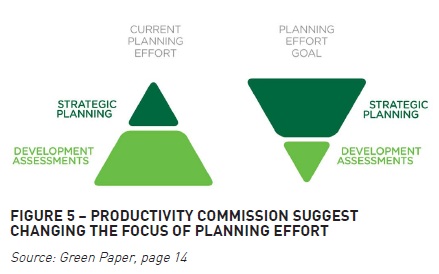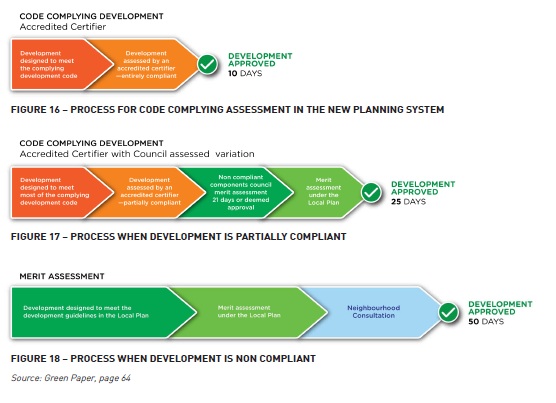The NSW Government's Green Paper, A new planning system for NSW' released on 14 July 2012 (Green Paper) lays out a blueprint for fundamental planning reform in NSW.
The primary intention of the proposed reforms is to reduce complexity, costs and delays, increase flexibility to facilitate investment, and improve transparency through increased stakeholder participation in decision making within the planning system.
The NSW Government is to be commended for taking steps to reform the NSW planning system. There is general community and industry consensus that the current planning system, after more than 30 years and numerous ad hoc amendments, has become too complex and inefficient.
While the reforms are generally positive, several of the proposed changes may cause practical problems that will need to be carefully considered in drafting the White Paper and the roll-out and implementation of the new legislation, in particular:
- By bundling numerous development controls into the proposed Local Land Use Plans (llUPs), there is a risk that the LLUPs will become overly cumbersome or, alternatively, fail to adequately address local land use issues.
- The Green Paper focuses on the timely delivery of infrastructure in connection with development, the provision of infrastructure by private developers and the provision of works-in-kind. In this respect, the proposal to wind-back the role of Voluntary Planning Agreements (VPas) may adversely impact on flexibility in the delivery of contributions and investment decisions of developers.
- Insufficient information is provided on what changes, if any, will be made to streamline State Significant Development (SSD) and State Significant Infrastructure (SSD).
- No detail on how the principles to improve the contributions system will be achieved is presently provided to enable an assessment of the merits of the proposed reforms.
- Care needs to be taken to ensure that the time constraints on assessments of partially compliant development will in fact facilitate approvals.
- The Green Paper is silent on many matters of importance to developers (see section 7 of this In Brief).
In this In Brief, we address specific issues arising from the Green Paper with an emphasis on what the proposed reforms mean from a developer's perspective. We point out that many of the significant proposed changes are only set out at a conceptual level in the Green Paper, with the 'nuts and bolts' to follow in the upcoming White Paper. The White Paper will be released later this year, or early next year, with the new legislation expected to come into effect mid-2013.
OUT WITH ASSESSMENT, IN WITH PLANNING
One of the more significant changes identified in the Green Paper will be a shift in emphasis from the development assessment phase to the strategic planning phase.

The following plans and policies are proposed as the cornerstone of the new planning system:
- NSW Planning Policies will replace State Environmental Planning Policies and 117 Directions and articulate policy direction to inform planning policy at all levels. Development control provisions will be collapsed into LLUPs or Subregional Delivery Plans.
- Regional Growth Plans will be integrated with the NSW Long Term Transport Master Plan and State Infrastructure Strategy and include provisions to facilitate growth and change over a 20 year period. It is intended that these plans will provide guidance for private sector investment and will utilise market and feasibility data.
- Subregional Delivery Plans will be prepared in partnership with local government, State agencies and stakeholders and in consultation with the community to provide the implementation mechanism for Regional Growth Plans. These plans will be underpinned by evidence based 'sectoral strategies'.
- LLUPs will replace Local Environmental Plans and aim to implement development controls that are more strategically focused and applied by way of guidance to promote flexibility (such as by providing for merit assessment rather than prohibition of non-complying development proposals).
Also, three new zones will be introduced to facilitate investment and preserve local character: These are the Enterprise Zone, Future Urban Release Zone and Suburban Character Zone.
A comparison between the current and proposed planning systems is set out below:

The shift in focus to strategic planning at the regional and sub-regional levels allows a greater opportunity for broader, non-local planning principles to be considered in development assessment. In particular, we support the significant proposed reduction in local planning controls from 300+ local environmental plans, supported by 1000s of development control plans, to 152 LLUPs. Similarly, there is a proposed reduction of 104 State and regional policies to just 10-12 planning policies. The primary challenge in implementing this system will be to provide the appropriate balance of certainty and flexibility.

NEW TIMEFRAMES AND DEEMED ... APPROVAL?
Development (excluding SSD and SSI) will now be split into three categories, depending on the proposed level of compliance with a revised complying development code:
- Code-compliant development;
- Development which is partially code-compliant; and
- Development which is not code-compliant
Significantly, development which is partially code-compliant will be deemed to be "approved" after the expiry of the stipulated 25 day assessment timeframe. While the shift from deemed refusals to deemed approvals is a positive step, the concern arises that consent authorities might default to refusal to grant development consent in circumstances where they do not have enough time or resources to assess the development or propose changes within the 25 day timeframe. This could potentially result in the need for an unnecessary review by an adjoining local council (as outlined in the next section), which council may be similarly resource constrained. The spectre of significant additional cost and time delays arising out of Class 1 merits appeals in the Land and Environment Court or as a result of a new development application will then arise.
No fixed timeframes have been set for assessment of development classified as SSD or SSI, although broad strategies for reducing the assessment time have been proposed. Overall, there is a lack of detail regarding how SSD or SSI development is to be treated under the new planning system.
THE REVIEW AND ASSESSMENT RESHUFFLE
Development applications will be filtered into the following streams of assessment:
| Development type | Decision maker |
| SSI (including Public Priority Infrastructure) | Minister |
| SSD | Planning Assessment Commission (Pac) / Department of Planning and Infrastructure (Department) |
| Regional | Joint Regional Planning Panel (JRPP) |
| Local | Council General Manager and staff under delegation / Local expert panel |
| Code Assessable | Council / Accredited certifier |
Review rights in relation to development application determinations which are currently governed by sections 82A and 96AB of the Environmental Planning and Assessment Act 1979 (EPA ACT) will be retained and expanded. The Green Paper sets out the bodies that are now proposed to review development application decisions. The avenues of review are:
- Department staff -> PAC
- Elected council members -> JRPP
- Council staff -> Senior staff member of an adjoining council or a small appeals tribunal
- Director General of the Department (DG) (in relation to a decision whether to issue a Strategic Compatibility or Site Compatibility certificate) -> JRPP
- JRPP or PAC -> No right of review
- Minister (in relation to a decision concerning Public Priority Infrastructure) -> No right of review
Existing appeal rights for both proponents and objectors under the EPA Act will be retained. Notably, a determination of a developer/land owner requested rezoning proposal will also be subject to a decision review process. An avenue of review is available at both the pre-gateway and gateway stage as follows:
- Pre-gateway determination -> JRPP
- Gateway determination -> DG with advice from the PAC
However, there is not proposed to be any appeal rights to a Court against a refusal of a rezoning request.
A FAIRER DEVELOPMENT CONTRIBUTIONS SYSTEM?
The contribution framework for State and local government infrastructure is to be reformed in line with stated key principles, including:
- no compromise to housing affordability;
- comparability with other jurisdictions;
- the 'beneficiary pays', 'avoidable cost' and 'cost reflectivity' principles;
- supporting contestability;
- subsidisation of costs where development in designated growth area; and
- a clear link between revenue collection and infrastructure delivery.
While no clear pathway to achieving these principles has been set out, the Green Paper proposes that a combination of Local Infrastructure Plans, Growth Infrastructure Plans and Regional Open Space Levies may govern infrastructure contributions for greenfield development, while infrastructure contributions for infill development would be calculated on the basis of a percentage of capital investment.
The upcoming White Paper will provide more detail on these reforms.
In the meantime, the Green Paper proposes that the actual payment of contribution levies will be required as late as practically achievable in the development process.
THE FATE OF VOLUNTARY PLANNING AGREEMENTS (VPAS)
Will VPAs disappear under the new regime? Not quite. While the Green Paper states that VPAs "need to be phased out or significantly modernised and simplified", this comment is qualified by "clear minimum" benchmarks for future VPAs:
- defined infrastructure performance outcomes;
- defined negotiation time frames having regard to land holding costs; and
- more development contributions in-kind and innovations to improve cost effectiveness.
The last two points present potential difficulties.
Firstly, the negotiation of VPAs is often a complex process and it is unclear what "sticks and carrots" may be imposed to speed up this process. Protracted VPA negotiation processes are presently costly and time consuming and, accordingly, reform is desirable. However, the imposition of an artificial deadline, particularly having regard to the complexity of some VPAs, may enable (or prompt) a party to entrench its position and not negotiate in good faith on the basis of a perceived benefit at the expiry of the deadline. This may well further undermine the already questioned "voluntary" nature of these agreements. Some benchmark "best practice" examples of provisions of VPAs that are usually the most contentious would arguably be a more useful tool to reduce negotiation timeframes and costs and to achieve better development outcomes.
Secondly, a greater emphasis on contributions in-kind, particularly where works deeds are required in lieu of VPAs, will lengthen rather than reduce the time for the negotiation of these infrastructure delivery agreements. This is because there is no standard template for these agreements, meaning negotiations and drafting will need to occur without guidance on commercially sensible outcomes. It is important that the contributions framework allows a developer and consent authority to agree on the most appropriate method for delivery of infrastructure without being locked into one documentation or delivery option.
LINKING GROWTH AND INFRASTRUCTURE
As stated above, infrastructure delivery will be governed by Local Infrastructure Plans and Growth Infrastructure Plans. It will also be governed by an in-progress 20-year State Infrastructure Strategy (scheduled for release in September 2012).
In line with a move toward greater transparency in the delivery of infrastructure, contributions will:
- be spent on infrastructure within the catchment for which they are received;
- be directed towards infrastructure provision and not lost in consolidated revenue; and
- be reported, showing collection, allocation and spending.
The State Infrastructure Strategy, Growth Infrastructure Plans and Subregional Delivery Strategies will all be made in a manner which, in theory, will result in a concerted and holistic approach to infrastructure delivery.
The Green Paper also proposes a new category of infrastructure: Public Priority Infrastructure. These major infrastructure projects are deemed as critical to growth in NSW and will be given the go-ahead at the strategic planning level. Further environmental assessment will then focus on managing environmental impacts rather than determining whether such projects will go ahead or not.
WHAT REMAINS UNCLEAR?
Acknowledging that the Green Paper is a high level snapshot of the proposed reforms only, it provides no insight on numerous matters of importance to the development industry. In particular:
- With the heavy emphasis on strategic plans, how will the preparation and implementation of those plans be resourced? Will the preparation of Regional Plans, Subregional Plans and Local Land Use Plans be completed in a timely manner so as to adapt to changing circumstances?
- What is happening to existing use rights?
- How does the Government propose to manage the certification of development and particularly the independence of certifiers? An increased emphasis on code-assessable development means that a more robust certification system is necessary to ensure continued high quality development outcomes in NSW.
- Will the orders/notices regime under the planning legislation be removed as part of the review of the EPA Act and the Local Government Act?
- What is happening to the transitional Part 3A arrangements – will they remain the same?
- Where merits assessment is required for a partially codecompliant development application, will the public be afforded an opportunity to make submissions?
- Will there be much change to the treatment of SSD and SSI developments and will the streamlining of those developments continue?
- Will the timeframe for 'physical commencement' of developments stay the same or will new time periods be adopted?
- Will the suspension of covenants provisions in section 28 of the EPA Act transfer to the new planning regime?
- Will there be any ongoing role for the Minister and the Director General in the development assessment process beyond that set out in the Green Paper?
- "Environmental Groups" will now have statutory participation rights in strategic planning. How will a legitimate "environmental group" be identified to ensure that the strategic planning process is not influenced by illmotivated interests?
- How will Part 5 transition into the new planning regime and how will Crown developments be treated?
Public comment on the Green Paper is being sought up until close of business of 14 September. A copy of the Green Paper is available here.
Please contact us if you have any queries regarding the Green Paper or require any assistance is preparing a submission.
The content of this article is intended to provide a general guide to the subject matter. Specialist advice should be sought about your specific circumstances.
 |
|
| Most awarded firm and Australian deal of
the year Australasian Legal Business Awards |
Employer of Choice for
Women Equal Opportunity for Women in the Workplace (EOWA) |


